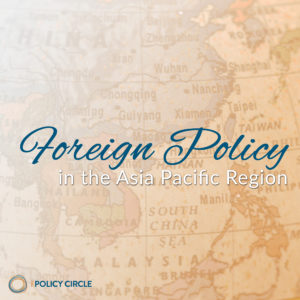What is the official U.S. policy towards North Korea and how do we deal with the nuclear threat they pose? What terrorist groups still threaten the U.S. and our allies in the Middle East and what should be done? What is “chain migration” and how do we deal with the “Dreamers”? What should U.S. immigration policy be?

As circles meet to kick off 2018, the suggested topic from The Policy Circle’s “A Year of Circle Conversations” curriculum is The U.S. and the World. Using one of the following briefs as a springboard for their roundtable discussions, here’s what members will be talking about:
Foreign Policy in the Asia Pacific Region
This region frequently makes the news these days due to rising tensions with North Korea over its nuclear ambitions. As you may know, U.S. officials have recently confirmed that North Korea now has the capability to launch a missile that could strike the continental United States. But did you also know that the Asia Pacific is responsible for 40% of the world’s GDP and is home to the U.S.’s 1st, 4th, and 6th largest trading partners? As the U.S. confronts a nuclear North Korea and an increasingly militarily and economically aggressive China while also balancing mutually beneficial trade relationships with a number of Asian allies, this part of the world will continue to have complicated national security and economic implications for the U.S.
Women discussing this new brief will dig deeper into these topics and gain an understanding of key threats and U.S. allies in Asia, as well as the important role that nuclear deterrence plays in U.S. strategy.
Foreign Policy: The Middle East
The Middle East is also a focal point these days, especially given the recent anti-regime protests in Iran and the Trump administration’s recent decision to officially recognize Jerusalem as the capital of Israel and to move the U.S. embassy from Tel Aviv. With this brief, circles will tour the threat landscape of the Middle East and the challenges posed to U.S. strategic and security interests, diving into al Qaeda, the Taliban, Islamic State, Hamas, Hezbollah, the Iranian regime, and the U.S alliance with Israel. The U.S.’s role in the world and American exceptionalism are also up for discussion with this brief.
Immigration, too, has been front and center in the news. Headlines such as ‘Voters Conflicted Over Family-First Immigration Policy’ and ‘Trump Opens New Front on Legal Immigration’ show how Americans are grappling with our current immigration policy. This brief looks at key terms and historical trends, such as the famines, wars and economic booms and busts that historically impacted U.S. immigration policy.
Immigration policy is often a discussion of numbers. Here are some of the interesting numbers you’ll find in the brief: In 1850, 10% of the U.S. population were immigrants versus an estimated 13.5% of the population in 2015, totaling over 43 million immigrants today. “By a wide margin, the U.S. has more immigrants than any other country in the world: one-in-five international migrants (19%) live in the U.S. The U.S. immigrant population is nearly four times that of the world’s next largest immigrant destination – Germany, with about 12 million immigrants,” as outlined by the United Nations, and Pew Research. And according to the State Department, approximately 4 million people are on the legal immigrant visa waiting list to gain a visa to enter the United States, with almost 98% of those individuals having been sponsored by a family member in the U.S.
With so many important policy discussions in the news, now is the time to get up to speed on the details, identify your role in the conversation and go beyond the headlines. We’re looking forward to hearing your thoughts and feedback after your January and February Policy Circle gatherings!
It’s a movement!
Recommend a Circle Leader. Especially in Nebraska, Wisconsin, Minnesota, Missouri and Michigan where circles are sprouting.
Start a Circle in your neighborhood. Add value in your community by giving women the facts and the space to strengthen their understanding of the issues.
Invest in The Policy Circle. Together let’s build a network of women who want to assume their civic duties and understand the impact of policy in their lives.
The Policy Circle is a 501(c)3 that provides a fact-based, nonpartisan framework that inspires women living in the same community to connect, learn about and discuss public policies that impact their lives. Women across the nation are taking a leadership role in public policy dialogue on what human creativity can accomplish in a free market economy.